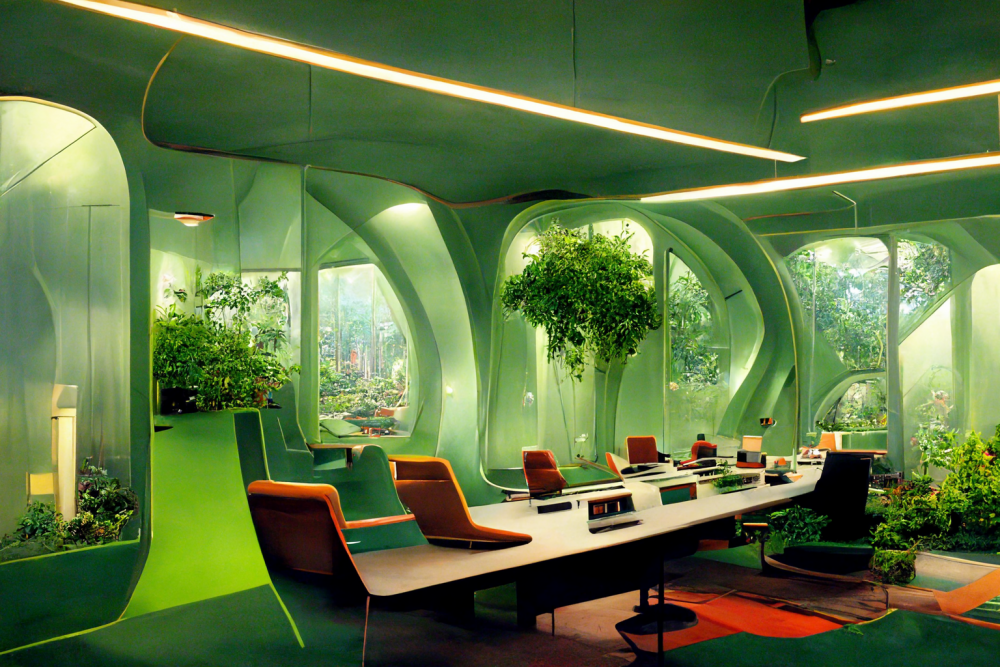Royce Epstein of Mohawk Group kicks off our 2023 trends series exploring the metaverse and its opportunities for interior design.
– Stay tuned as we share more 2023 trends for the entire month of December & beyond –

One emerging cultural shift today is the Metaverse. The term, introduced in the 1992 book Snow Crash by Neal Stephenson, refers to an alternate reality that is virtual. This pre-dated the internet, living in the realm of speculative design and science fiction. However, the Metaverse is functional today as the internet evolves into Web 3.0; it is the next frontier where businesses and brands will connect with consumers to drive culture and design, enabling new modes of experience in a highly interactive version of the internet. This will influence every aspect of society through work, learning, healthcare, socializing, shopping, and play.
The intent of the Metaverse is to be inclusive of community-based behaviors, foster collective transparency, and practice equity based on decentralized power. The Metaverse does not have physical limits, and it is democratized, so anyone can participate if they have internet connection. Another feature is the authentication of objects and design, so it is secure and fair for anyone owning digital assets. This is not a coincidence, as the metaverse reflects the social values of youth generations and how they want to shape this emerging world. It also can be viewed as a utopia, where people seek refuge in a place that aligns with their aspirations.
An easy way to think about the Metaverse is as a series of virtual environments.
An easy way to think about the Metaverse is as a series of virtual environments. It’s not the built environment in the same structural and material sense as architecture and interiors, but it is indeed built with online tools. There are communities that are space and place based, such as Decentralized. Users can develop and build on their “land”, create their own environments, and designate space for specific functions. These serve as virtual environments where people come together for a common purpose. In this sense, digital spaces are not different from physical ones because they are essential for human connectivity.
Also popular in the Metaverse is digital architecture and real estate, slated for exponential growth. Virtual real estate sales reached over $500 million in 2021 and is expected to reach $800 billion by 2030. Hence there are huge opportunities for design, including designing digital twins of physical space, creating virtual spaces for commercial clients, along with all the stuff that goes in them (furniture, carpet, wallcovering, avatars, fashion, etc.). Imagine using the Metaverse for meetings in designed spaces with our avatars face-to-face instead of Zoom! This is where the meta world is heading.
Our industry will shift to be inclusive of this practice, and we are already seeing examples of this.
So how can our A&D industry contribute to building the Metaverse? It is clear spaces will need to be designed and built in the meta world, as the demand is there. Our industry will shift to be inclusive of this practice, and we are already seeing examples of this. Bjarke Ingels’ firm BIG designed a virtual office for Vice Media Group, known as Viceland. This virtual space lives on the Decentralized platform and serves as Vice’s online innovation lab. Zaha Hadid’s office designed an entire city called Liberland in the same vernacular as her iconic architecture.
Additionally, we will begin to see new and expanded roles in our industry: expansion of the term architect to include those who design in digital spaces (such as a Meta-Architect); Design Prompters to operate AI design software; Design Programmers (in additional to traditional Space Planners); and more that we can’t imagine yet. These designers will need to know about game design, programming in the software sense, and user interface. As for finishes and materials, these will also be replicated in the metaverse and now we will have Digital Weavers or Digital Fabricators for our virtual FF&E. We also see a rise in co-design, where users and consumers are selecting their preferred designs for their avatars and virtual environments.
…We will be able to serve the needs of all clients and communities in a more immediate way where space and time converge in phygital settings.
Once our A&D industry embraces the shift to the metaverse, we will be able to serve the needs of all clients and communities in a more immediate way where space and time converge in phygital settings. These spaces will be more inclusive and equitable, as we can transport ourselves between the built world and the meta one with no barriers. This is design for the future.

